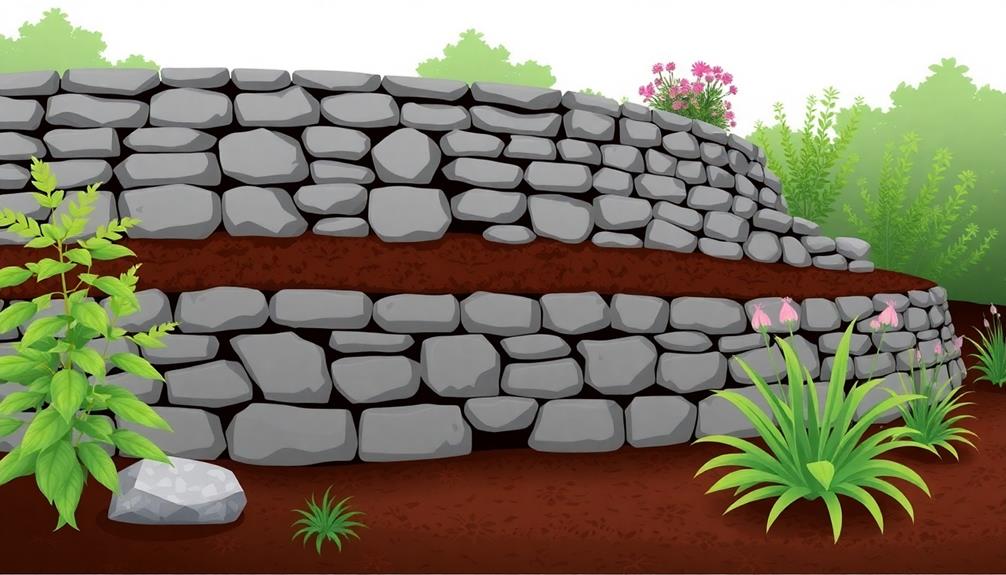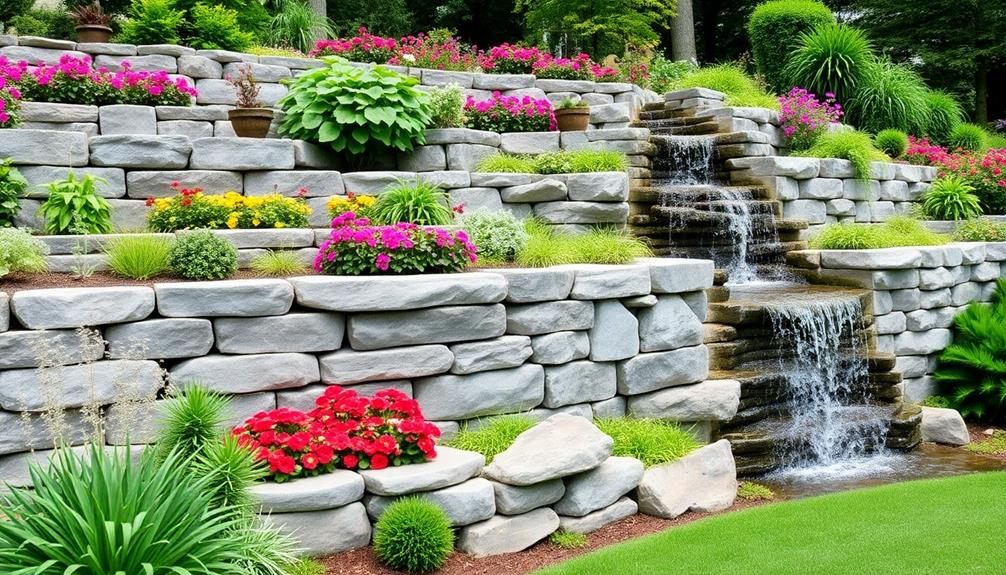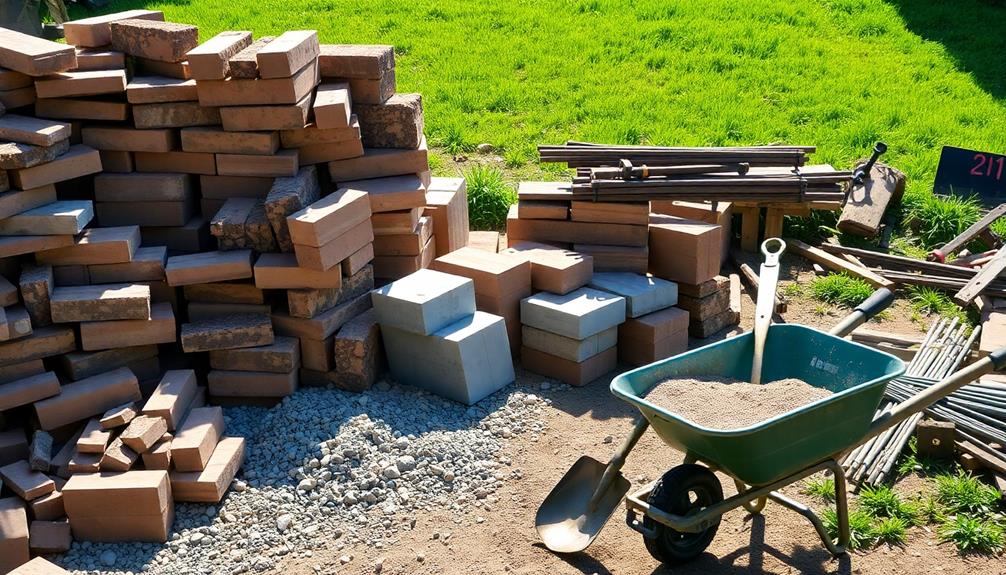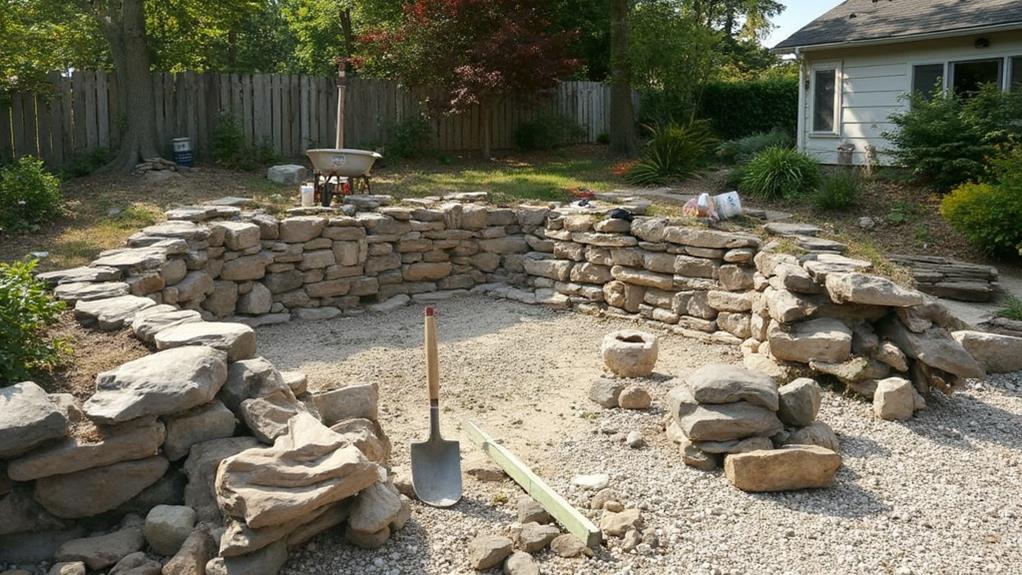Constructing a retaining wall begins with evaluating site conditions such as soil type and drainage, determining its dimensions, and securing necessary permits. Prepare the site by clearing vegetation and excavating a foundation that supports a stable base. Select suitable materials from options like concrete blocks or natural stones for desired aesthetics. Lay the foundation and install the first course, ensuring levels and alignment. Gradually build up the structure with backfill and reinforcement, integrating drainage solutions like weep holes. Finalize by installing a cap and landscaping. Abide by safety regulations throughout the process and perform final inspections for integrity and compliance before maintenance begins, revealing additional insights into ideal construction practices.
Table of Contents
ToggleWalls Contractor Highlights
- Assess site conditions and prepare by clearing vegetation, ensuring proper drainage, and excavating the foundation.
- Lay a solid concrete foundation for a stable base and install level first course of wall blocks or stones.
- Backfill with gravel behind the wall to aid drainage and continue stacking courses while staggering joints.
- Incorporate drainage elements like weep holes or subsurface systems to prevent water buildup behind the wall.
- Cap the wall for a finished look and inspect for structural integrity, ensuring compliance with local regulations.
Definition of Retaining Wall

A retaining wall serves a fundamental purpose in landscape architecture and construction by providing essential support to vertical or near-vertical changes in ground elevation, preventing soil erosion and managing water runoff efficiently. These structures can be constructed from a variety of materials such as concrete, stone, or timber, each offering distinct advantages and fitting different architectural aesthetics and site requirements.
For example, boulder walls utilize natural stone materials like limestone and granite, providing both durability and a natural look, which is important for shoreline restoration and erosion control. Additionally, the design of a retaining wall must adhere to specific engineering principles and adhere to local regulations to guarantee stability, durability, and environmental compliance, ultimately making careful consideration of its functionality and integration crucial.
Purpose and Functionality
When planning outdoor landscaping projects, understanding the purpose and functionality of retaining walls is crucial. Retaining walls do more than simply support varying levels of earth; they serve as essential structures that prevent soil erosion, manage water flow, and create usable flat areas on sloped landscapes.
For those seeking harmony and stability in their outdoor environments, these walls provide a foundation for added aesthetic appeal and practicality. Retaining walls transform challenging terrains into efficiently structured spaces while ensuring the safety and integrity of the landscape.
In your quest for a landscape that seamlessly blends functionality and beauty, consider the following purposes of retaining walls:
- Erosion Control: Retaining walls combat the natural forces of erosion by holding back soil and minimizing the effects of rainfall and runoff.
- Water Management: These structures can aid in diverting water away from foundations, reducing the risk of flooding or water damage.
- Space Optimization: By leveling out slopes, retaining walls create additional space for gardens, patios, and other outdoor features.
- Aesthetic Enhancement: Offering a unique feature in your landscape design, retaining walls can be designed with various textures, colors, and architectural styles to complement your environment.
Materials and Types
Numerous materials and types of construction give retaining walls their versatility and adaptability to diverse landscape needs. There are significant factors to ponder when selecting the appropriate materials, each offering distinct benefits suited to varying environmental conditions and aesthetic preferences.
Commonly-used materials include concrete, stone, brick, and timber, with each boasting unique structural capabilities and visual appeal. Concrete retaining walls are renowned for their durability and strength, making them ideal for supporting substantial loads and resisting environmental pressures. They can be crafted into various configurations, providing design flexibility for custom projects.
Stone retaining walls, on the other hand, offer an elegant, timeless appearance, blending seamlessly into natural settings. Chosen often for their aesthetic value, they can be constructed from a variety of stones depending on local availability, contributing to environmental integration. Brick walls offer a classic, uniform look, suitable for residential applications where aesthetics and moderate structural support are desired. Timbal retaining walls provide a rustic charm, commonly used in temporary or light-load scenarios due to their lower cost and ease of installation.
The selection among these materials depends on functional needs, environmental constraints, and personal style, ensuring that every retaining wall can uniquely serve its intended purpose.
Design and Regulations
Understanding the design and regulatory framework for constructing retaining walls is essential for ensuring safety, compliance, and effectiveness. A retaining wall is a structure designed to hold or retain soil, preventing erosion and managing terrain slopes.
When undertaking such a project, it's imperative to ponder the design principles that influence its stability and longevity. These include wall height, slope angles, and material strength, which must harmonize with the environmental and soil conditions of the site. Additionally, adhering to local regulations and codes is indispensable to meet legal necessities and enhance community acceptance.
Designing retaining walls requires thoughtful consideration of both functionality and aesthetics, balancing practical demands with visual appeal. In this collaborative endeavor, stakeholders work together to create structures that respect nature while serving human needs.
Key aspects of retaining wall design and regulation include:
- Site Analysis: Evaluating geographical and geological conditions to inform design choices.
- Structural Integrity: Ensuring that materials and designs conform to engineering standards.
- Permits: Securing necessary approvals from local authorities before commencing construction.
- Environmental Impact: Examining and mitigating effects on local ecosystems and drainage patterns.
These components form the foundation for successful project implementation, fostering belonging within the community.
Benefits

Constructing a retaining wall offers several significant benefits, including the prevention of soil erosion, which helps maintain the integrity of your landscape while reducing long-term land degradation.
It can also create usable backyard space with steps or even provide an opportunity for landscaping enhancements with features like flowers or water integration.
Beyond its functional advantages, a well-designed retaining wall can enhance the aesthetic appeal of your property, potentially increasing its market value.
Furthermore, it provides essential structural support, particularly on properties with varying elevations, ensuring stability and safety in outdoor spaces.
Prevents Soil Erosion
Retaining walls offer the tangible benefit of effective soil erosion prevention, serving as an indispensable solution in landscaping and construction projects. By employing these robust structures, homeowners and property developers can mitigate the natural forces that lead to soil displacement, consequently preserving the integrity and health of the landscape. With an understanding that our surroundings depend on sturdy soil foundations, retaining walls fulfill a critical role by stabilizing slopes and preventing the detrimental effects of erosion, such as landslides and sediment runoff. This functionality becomes particularly important in areas prone to heavy rainfall and steep inclines, where erosion poses a significant threat.
To further elucidate the advantages of retaining walls in preventing soil erosion:
- Structural Support: Retaining walls provide essential reinforcement to unstable soil, reducing the likelihood of erosion-induced damage.
- Water Flow Regulation: They help manage and reroute water flow, thus minimizing the risk of waterlogged soil and erosion.
- Increased Usable Land: By creating level areas, retaining walls offer additional space for gardens or recreational activities.
- Eco-Friendly Design: These barriers can be constructed using sustainable materials, supporting an environmentally conscious approach to landscaping.
As a community connected by the shared goal of preserving our environments, retaining walls offer security and stability to safeguard our landscape legacy.
Increases Property Value
Elegantly designed and skillfully constructed retaining walls can markedly enhance a property's value, offering both aesthetic appeal and practical functionality. By serving as integral structures within a landscape, retaining walls provide invaluable support, redefining sloped areas and creating leveled spaces which can be transformed into usable land. This addition not only optimizes the space—making properties more versatile and attractive to prospective buyers—but also signals careful attention to the infrastructure and longevity of a home.
Moreover, retaining walls embody a strategic investment in residential stability and safety. With their ability to manage soil movement and drainage, these walls mitigate risks associated with erosion and water damage, indirectly fostering long-term savings on potential repairs. For properties situated in regions prone to such issues, a well-implemented retaining wall can differentiate a home within the market, highlighting it as an enhanced and thoughtfully improved asset.
Furthermore, these structures often come in a variety of materials—ranging from concrete blocks to natural stones—each offering unique durability and visual texture. This versatility enables homeowners to choose walls that harmoniously align with their property's architectural style, ultimately creating a cohesive, appealing environment that resonates with buyers' expectations for quality and robustness.
Enhances Landscaping Aesthetics
A strategically designed retaining wall can greatly elevate a landscape's visual appeal, creating a polished and welcoming atmosphere. These structures seamlessly integrate with the natural environment, offering a sense of harmony and cohesion to any outdoor space.
By delineating functional areas, they provide both a visual framework and an opportunity to showcase aesthetically pleasing design elements. Engaging textures, vibrant colors, and innovative materials contribute to a dynamic and personalized landscape that reflects the unique tastes of its inhabitants.
Implementing a retaining wall can transform ordinary terrains into eye-catching displays, enhancing both individual expression and communal belonging within a neighborhood.
Multifunctional landscape design: Retaining walls serve as artistic focal points that can guide the eye through a garden or yard.
Utilization of diverse materials: From rustic stone to sleek concrete, the variety in materials allows for customization that suits personal aesthetic preferences.
Visually striking tiered gardens: Terracing with retaining walls enables the creation of multi-level gardens, increasing plantable space while enhancing visual interest.
Illumination integration: Incorporating lighting within retaining walls can highlight their features at night, adding another layer of beauty and safety.
Provides Structural Support
Well-constructed retaining walls are essential for providing the structural support needed to manage and stabilize uneven terrains. These walls act as a critical solution for preventing soil erosion and managing water flow, particularly in areas prone to heavy rainfall or slopes. By stabilizing these surfaces, retaining walls safeguard not only landscapes but also infrastructures such as roads and buildings from potential damage caused by soil movement. Their ability to withstand lateral pressure from soil is indispensable, maintaining the integrity of your property's topography and the safety of structures situated nearby.
In addition to ensuring soil stability, retaining walls serve as a resilience-enhancing element in land development projects. They allow for the reformation of steep gradients into usable, level spaces, thus adding functional value to properties. This transformation is not merely structural but also practical, enabling the creation of terraced gardens, driveways, and pedestrian pathways. Such walls can be constructed from a variety of materials, including concrete blocks, wood, and natural stone, each offering unique benefits in terms of strength and aesthetics. By choosing a retaining wall engineered to cater to specific site conditions, property owners can achieve the most suitable support and longevity, fostering a sense of security and unity within their community.
Common Construction Materials

In constructing a retaining wall, selecting the appropriate materials is essential to guarantee stability, durability, and aesthetic appeal, making it indispensable to understand the various types available, their respective advantages, and drawbacks. Popular materials used in retaining wall construction include concrete blocks, natural stone, and timber, each offering distinct characteristics that may influence your choice based on factors such as budget, environmental conditions, and design preferences. The table below outlines these wall materials, highlighting their pros and cons to aid in selecting the most fitting option for your project.
| Wall Material | Pros | Cons |
|---|---|---|
| Concrete Blocks | Durable, uniform appearance | May require professional installation |
| Natural Stone | Aesthetic, environmentally friendly | Costly, labor-intensive installation |
| Timber | Affordable, easy to install | Less durable, requires maintenance |
Types of Wall Materials
Selecting the appropriate materials for constructing a retaining wall is crucial for its durability and effectiveness. The choice of materials not only influences the wall's aesthetic appeal but also its fundamental strength and longevity. When thoughtful selection is made, it aptly reflects the distinctive character of the surrounding environment, thereby fostering a sense of belonging among homeowners and community members alike.
To assist in making informed decisions, consider the following common construction materials frequently utilized in retaining wall construction:
- Concrete Blocks: A popular choice due to their versatility, concrete blocks offer a high degree of strength and can be easily adapted to suit various wall configurations. Their modular nature simplifies the construction process and accommodates intricate designs.
- Natural Stone: Known for its timeless beauty, natural stone imparts an organic look that blends seamlessly with natural landscapes. Each wall bears an individualistic charm, contributing to the overall aesthetic of outdoor spaces.
- Brick: Offering a traditional appearance, brick retaining walls exude a classic charm, easily harmonizing with existing architectural elements. Their robust nature ensures long-term stability.
- Timber: Suitable for landscapes requiring a rustic touch, timber walls offer an earthy appeal. However, quality wood treatment is essential to prevent decay and prolong lifespan.
The deliberate selection of construction materials serves as a foundational step in creating retaining walls that are both functional and visually appealing.
Pros and Cons Explained
When evaluating the suitability of various construction materials for retaining walls, understanding the inherent pros and cons of each option is essential. Concrete, for instance, stands out for its durability and strength, making it a preferred choice for substantial projects requiring long-term stability. Its notable disadvantage, however, includes relatively high costs and labor-intensive installation.
Meanwhile, timber offers a more aesthetic and cost-effective solution, appealing to those who value natural beauty and ease of installation. Yet, timber's susceptibility to rot and insect damage presents significant long-term maintenance challenges.
Stone, often revered for its timeless appearance and structural integrity, provides an enduring and robust solution. It necessitates careful installation and can be prohibitively expensive, particularly for larger constructions.
Brick walls, combining aesthetic appeal with moderate cost, serve well in many residential settings, fostering a sense of traditional charm. Their limitation lies in potential erosion and weather-related degradation.
Choosing Appropriate Options
Careful consideration of construction materials is paramount when designing an effective retaining wall, as the choice directly influences the wall's functionality, lifespan, and overall cost. Selecting appropriate materials forms the foundation not only of the wall's structural integrity but also of its aesthetic alignment with its surroundings.
In our communities, each construction project brings together individuals and environments, demanding materials that cater to specific needs while enhancing the shared space.
Among the myriad of options available, four common materials merit attention:
- Concrete Blocks: Durable and versatile, concrete blocks are widely used for their ability to withstand substantial weight and environmental wear while offering flexibility in design, providing a sense of stability to the community.
- Natural Stone: Renowned for its timeless beauty and strength, natural stone offers an organic appearance, blending seamlessly into landscapes and fostering a connection with nature, which can be immensely rewarding for those who seek belonging in their surroundings.
- Timber: Offering a rustic and warm aesthetic, timber is favored in projects where a softer, more natural look is desired. It also emphasizes harmony in community spaces, where inclusivity is paramount.
- Brick: Durable and visually appealing, bricks provide a classic charm that can seamlessly integrate with traditional architecture, promoting a sense of continuity and unity within the neighborhood.
Walls Contractor FAQ
What Is the Best Time of Year to Build a Retaining Wall?
The ideal period for constructing a retaining wall typically falls during early spring or late fall. This timing guarantees suitable weather conditions, encouraging a harmonious blend of teamwork, efficiency, and community engagement in outdoor construction endeavors.
Can a Retaining Wall Be Constructed on a Slope?
Constructing a retaining wall on a slope is feasible with careful planning and design. Maintaining the slope's stability and incorporating drainage solutions is crucial. Seeking professional assistance guarantees the wall's durability and adherence to safety standards.
How Long Does It Typically Take to Build a Retaining Wall?
The duration to build a retaining wall depends on various factors including material choice, wall size, site conditions, and crew experience. Typically, it ranges from a few days to several weeks, fostering a sense of achievement and progress.
Do I Need a Permit to Build a Retaining Wall?
Yes, obtaining a permit for constructing a retaining wall is often required, as regulations vary by location. Consulting local building codes and municipal regulations will guarantee compliance and demonstrate your commitment to maintaining community safety standards.
How Can I Prevent Water Damage to My Retaining Wall?
To prevent water damage to your retaining wall, guarantee proper drainage by installing a drainpipe or gravel backfill behind the wall. Regular maintenance, including checking for blocked drains, fosters a solid and lasting community structure.







